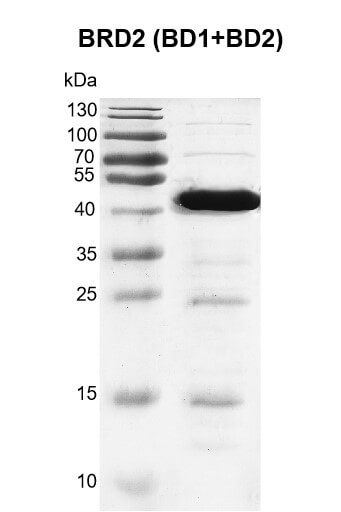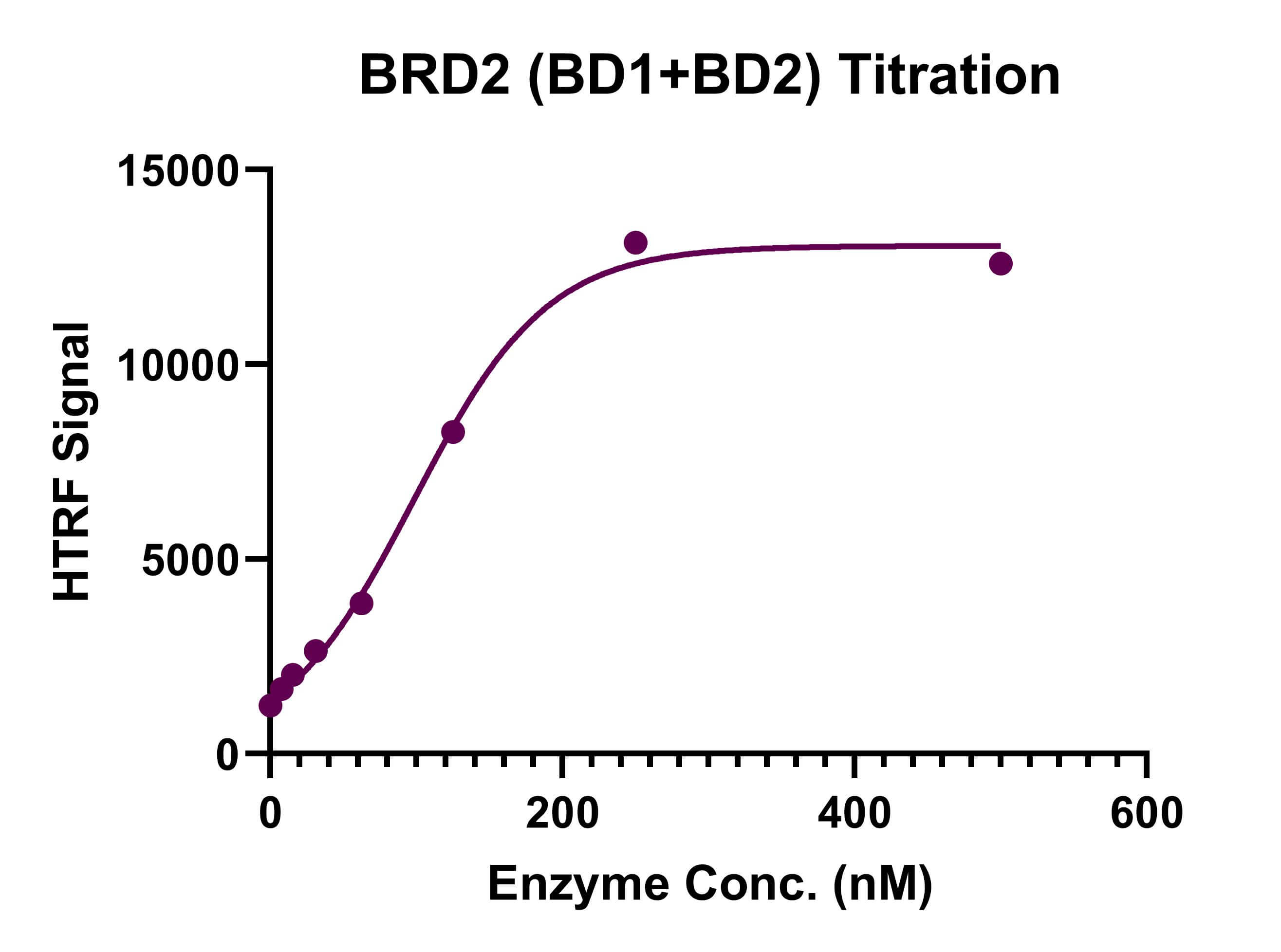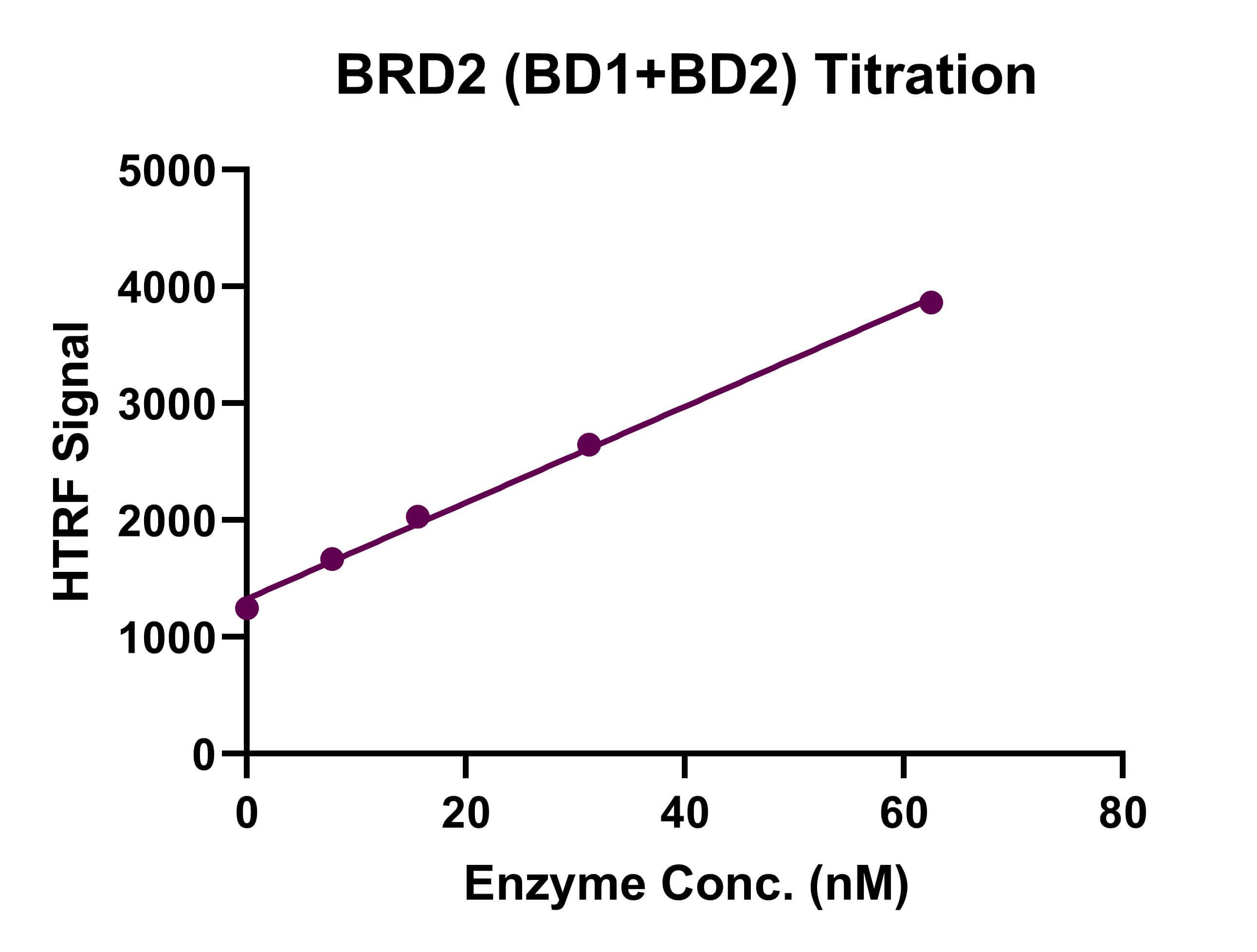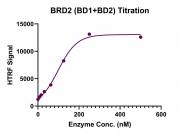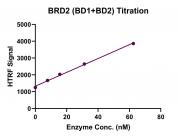Recombinant BRD2 (BD1+BD2) protein
| Aliases: FSH; NAT; RNF3; FSRG1; RING3; D6S113E |
| Catalog No: 81435 | Format: 50 µg | $450 | Buy |
| Catalog No: 81535 | Format: 1 mg | $3,000 | Buy |
Request a quote for a bulk order Request Quote
Expressed In: E. coli Protein Species: Human
Contents
A representative Technical Data Sheet (TDS) is provided here. Please refer to the lot-specific TDS you will receive with your order for the lot-specific buffer contents and protein concentration.
Background
Bromodomain-containing protein 2 (BRD2), also known as RING3, belongs to the BET subclass of proteins, which are characterized by two N-terminal bromodomains and one ET (Extra Terminal) domain. BRDs associate with chromatin through their bromodomains that recognize acetylated histone lysine residues. Bromodomains function as ‘readers’ of these epigenetic histone marks and regulate chromatin structure and gene expression by linking associated proteins to the acetylated nucleosomal targets. The ET domain functions as a protein binding motif and exerts atypical serine-kinase activity. The BET family consists of at least four members in mouse and human, BRD2 (also referred to as FSRG1, RING3), BRD3 (FSRG2, ORFX), BRD4 (FSRG4, MCAP/HUNK1), and BRDT (FSRG3, BRD6). BRD proteins are related to the female sterile homeotic protein gene in Drosophila, a gene required maternally for proper expression of other homeotic genes, such as Ubx, which is involved in pattern formation. BRD2 causes elevated protein kinase activity in leukemias. Transgenic mice overexpressing BRD2 in the lymphoid system develop diffuse large-cell lymphoma. BRD2 has been shown to interact with E2F1 and with histone H4 acetylated at Lys12 via its two bromodomains. BRD2 may play a role in spermatogenesis or folliculogenesis. Genetic evidence links the BRD2 gene to both juvenile myoclonic epilepsy and photoparoxysomal responses.
Application Notes
This product was manufactured as described in Protein Details. Where possible, Active Motif has developed functional or activity assays for recombinant proteins. Additional characterization such as enzyme kinetic activity assays, inhibitor screening or other biological activity assays may not have been performed for every product. All available data for a given product is shown on the lot-specific Technical Data Sheet.
Protein Details
The protein corresponding to amino acids 71-455 that contains the bromodomain sequence of BRD2 (accession number NP_001106653.1) was expressed in E. coli and contains an N-terminal His tag with an observed molecular weight of 45.51 kDa. It shows binding specificity for acetylated H4K5, H4K5/8, H4K5/12, H4K8/12, H4K12/16, H4K12/16/20 and H4K5/8/12/16
References
Human
Recombinant BRD2 (BD1+BD2 protein
12.5% SDS-PAGE Coomassie staining
MW: 45.51 kDa
Purity: ≥ 85%
HTRF Assay for Recombinant BRD2 (BD1+BD2) activity.
3 µM histone peptide H4K5/8/12/16(ac4) was incubated with BRD2 (BD1+BD2) in reaction buffer including 50 mM HEPES-NaOH pH 7.0, 0.1% BSA for 1 hour at room temperature. Anti-His antibody was used to detect reaction products.
HTRF Assay for Recombinant BRD2 (BD1+BD2) activity.
3 µM histone peptide H4K5/8/12/16(ac4) was incubated with BRD2 (BD1+BD2) in reaction buffer including 50 mM HEPES-NaOH pH 7.0, 0.1% BSA for 1 hour at room temperature. Anti-His antibody was used to detect reaction products.
Storage
Recombinant proteins in solution are temperature sensitive and must be stored at -80°C to prevent degradation. Avoid repeated freeze/thaw cycles and keep on ice when not in storage.
Guarantee
This product is for research use only and is not for use in diagnostic procedures. This product is guaranteed for 6 months from date of arrival.

